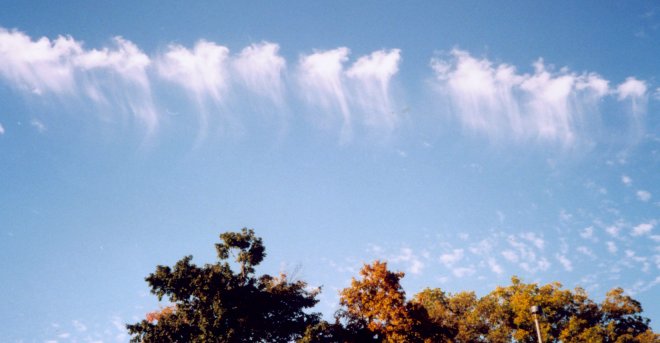SKYLIGHTS

Photo of the Week.. Ranks of icy clouds point to
Earth.
Astronomy news for the week starting Friday, January 4, 2002.
Happy New Year and welcome to 2002. The next Skylights will appear
on Sunday, January 13.
The Moon passes its last quarter the night of Saturday, January 5,
about the time of midnight in the Americas. Since the Sun just
passed the winter solstice in Sagittarius, the third quarter, 270
degrees around its orbit from the Sun, will be just past the
autumnal equinox in Virgo. The
night of Monday, the 6th, the Moon will appear just up and to the
right of Virgo's Spica. The lunar
disk will then wane as an ever-thinning crescent within the
southern part of the zodiac.
Three bright planets now grace the evening sky. Though the Earth
is steadily pulling ahead of Mars, the Martian march to the north
delays its setting, so the red planet is still up in the west until
10 PM. Far to the east, Saturn and Jupiter dominate the northern
sky. Both planets are in retrograde motion, Saturn in Taurus near the Hyades, Jupiter in Gemini and nearly as far north as
it can get. These planets are so far to the north that they are
actually circumpolar -- never setting -- for the most northerly
part of the US, Barrow, Alaska (and Jupiter even a few points
south), which is now in 24-hour darkness. The waning crescent
Moon, however, will be out of sight for them. Back to mid-
latitudes, little Mercury is also visible this week low in twilight
southwestern skies, as it reaches greatest eastern elongation from
the Sun on Saturday, the 11th. The other planets are too close to
the Sun to be seen, and Pluto, of course, too faint unless you have
a good-sized telescope. In the "for what it is worth" department,
Mercury and Neptune come into conjunction with each other on
Wednesday, the 8th.
Winter finds us at Orion season, the giant hunter transiting the
meridian around 11 PM, brilliant Sirius in Canis Major down and to the left. Orion is obvious, but many
constellations are not. At around 50 degrees below the celestial
equator, skimming the horizon for those in mid-northern latitudes,
is a string of dim "modern" constellations. Eastward from Fomalhaut in ancient Pisces Austrinus we find Sculptor
(indeed yes, the Sculptor), Fornax
(the Furnace), below Orion Columba
(the Dove), and east of Canis Major, Pyxis (the Compass), and Antlia (the Air Pump). Below
Orion and above Columba find another ancient constellation, Orion's
small prey, Lepus, the Hare,
rather easily recognized as an elongated, distorted rectangle of
stars.







